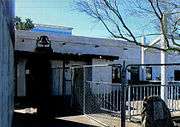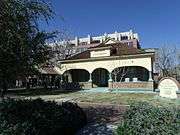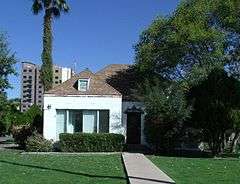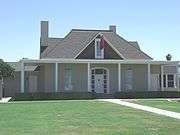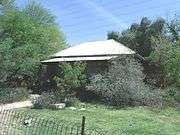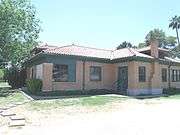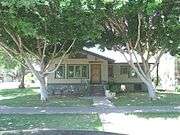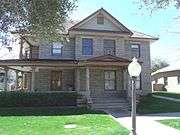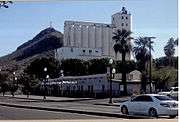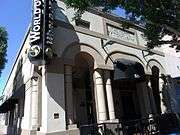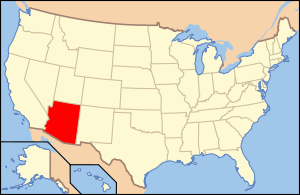The Double Butte Cemetery is the official name given to a historic cemetery in Tempe, Arizona. The cemetery was founded in 1888 on the baseline of the Double Butte Mountain for which it is named. It is the final resting place of various notable pioneers of the City of Tempe. The cemetery, which is located at 2505 W. Broadway Rd., is listed in the Tempe Historic Property Register Designation #46. The pioneer section of the cemetery was listed in the National Register of Historic Places on July 30, 2013, reference #13000020.
History
Many interments, where the present cemetery is located, had already occurred before the official establishment of the cemetery. This fact prompted a group of citizens to form a group called, "Tempe Cemetery Association". The Tempe Cemetery Company, officially established the cemetery on September 13, 1887. The property was donated by Niels Peterson in 1888. Peterson himself was buried there until 1923, when he was exhumed and re-interned in the property where his historic house is located. The location was chosen not only because of its seclusion, since it is situated several miles from the town (Tempe was not considered a "city" at the time) limits, but because the buttes served as a prominent geographical marker. The officers of the Tempe Cemetery Company formed the first corporate entity to administer the cemetery. The first section to be professionally developed by the Tempe Cemetery Company, was the “Pioneer Section” located adjacent to earlier, pre-1897 burials.[2][3]
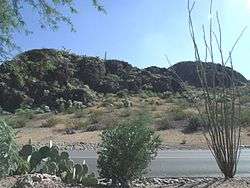
The Double Butte Cemetery is located on the baseline and named after the Double Butte Mountain
For the next decade, Double Butte grew to become Tempe’s primary burial place.[2][3] The economic situation in the 1920s and 30's also had its effects on the cemetery. The Tempe Cemetery Company was in dire financial straits, and the cemetery itself suffered immensely as a result. Many of the graves were sunken and the area around them, such as the trees and grass, began to die because of lack of water and care.[2][3]
In 1958, the City of Tempe assumed the obligations to operate the cemetery. After sixty years of private, volunteer-organization management, the Tempe Double Butte Cemetery fell under the administration by the City of Tempe. It remains under city ownership and administration to this day.[2][3]
The Double Butte Cemetery is the final resting place of Charles Trumbull Hayden (founder of Tempe); Carl T. Hayden (Arizona senator, 1927-1969); Dr. Benjamin Baker Moeur (Arizona governor, 1932-1936); John Howard Pyle (Arizona governor, 1950-1954) and U.S. Congressman John Robert Murdock. It is also the final resting place of eleven of Tempe's mayors and of many prominent citizens who quietly played their own respective roles in the community’s
evolution over the past century and whose houses are listed in the National Register of Historic Places.[2][3]
The cemetery is located at 2505 W. Broadway Rd. and covers 17 acres (6ha 8796.6m² hectares). It was listed in the Tempe Historic Property Register Designation with the number 46 in 2012. The pioneer section of the cemetery was listed in the National Register of Historic Places on July 30, 2013, reference #13000020.[2][3] It is divided into 31 sections. The pioneer sections are listed by letters A to G and the other sections are listed by numbers 1 to 12 and 14 to 23. Then there are the Sunrise Section, which is a lawn covered section; the Sunset Section, which is at the base of the butte next to the Memorial Gardens and the Memorial Gardens section, for the interment of cremated remains.[2][3]
Notable burials
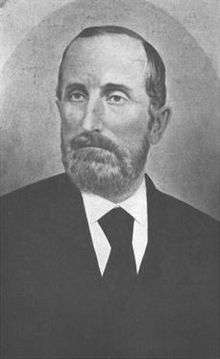
Charles Trumball Hayden, founder of Tempe
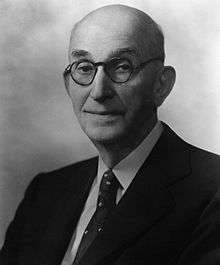
Carl T. Hayden, U.S. Senator
.jpg)
John Howard Pyle, Governor of Arizona
Among the notable people who are listed here are the founder of Tempe, two Arizona governors, a United States Senator, a United States Congreesman, 5 mayors of Tempe and various prominent pioneers of Tempe.[2]
[3][4][5][6][7][8]
[9][10]
[11]
Pioneer section A
- Curtin “Curt” W. Miller (1864-1943). Miller served as Mayor of Tempe from (1922-1924). He is buried in Sec. A.[12]
Pioneer section B
- Margaret Cummins (1853-1930) and Aaron Cummins (1840-1919). The Cummins were pioneers who acquired the undeveloped lot 10 of block 1 of the Farmers Addition in 1908. There the family built a house which is listed in the National Register of Historic Places. The Cummins are buried in sec. B.[3]
- Josephine Frankenberg (? – 1949). Frankenberg was a nurse who nursed many victims of the Great Influenza epidemic of 1918, back to health. In 1919 she purchased a house which is listed in the National Register of Historic Places as the Josephine Frankenberg house. She lived in the house until her death in 1949. Frankenberg is buried in sec. B.[7]
- Clyde Harlen Gililland (1899-1968). Gililland served as Mayor of Tempe from (1960-1951). He is buried in Sec. B.[12]
- Dr. Fenn John Hart (1859-1935). Dr. Fenn John Hart was the first Mayor of Tempe. He served as such from 1894 to 1896. Hart is buried in sec. B.[12]
- Charles Trumbull Hayden (1825-1900). Hayden was the founder of the city of Tempe and the Arizona State University. He is the father of U.S. Senator Carl T. Hayden. He is buried in sec. B.
- Carl Trumball Hayden (1877- 1972). Hayden was the first United States Senator to serve seven terms. He served as Arizona’s first representative for eight terms before entering the Senate, Hayden set the record for longest serving member of the United States Congress more than a decade before his retirement from politics. He is buried in sec. B-53.[13]
- Cyrus Grant Jones (?-1926). After Jones moved to Tempe he became the first president of the Tempe National Bank. Jones is buried in sec. B.[12]
- John Knight (1854-1904). Knight served as Mayor of Tempe from (1897-1902). He is buried in Sec. B.[12]
- Albert E. Miller (1859-1909). Albert was the son of Tempe pioneer Winchester Miller. He was a founding member of the Tempe National Bank. Miller is buried in sec. B.[14]
- Winchester Miller (?-1893). Miller was a pioneer who made his home in Tempe. He was a former soldier in the Confederate Army of the United States who moved to Arizona after the American Civil War ended. Within a few years he had one of the most prosperous farms in the Valley. He was president of the Tempe Irrigating Canal Company and served as Maricopa County Sheriff in the 1870s and 80s. He was also a trustee of the Tempe School District # 3. Miller is buried in sec. B.[9]
Pioneer section C
- Charlotte Josephine Mullen Goodwin (1884-1973). Charlotte was a pioneer and widow of Garfield Abram Goodwin. Her house is listed in the National Register of Historic Places. She is buried in sec. C.[11]
- Garfield Abram Goodwin (1880-1944). In 1907, Goodwin owned a curio store which was located in a building which he built in Mill Ave. and which is known as the Goodwin Building. He served in various civil service positions in Tempe such as head of the Tempe Beach Committee, Secretary of the Arizona State teachers College Board of Education and as mayor of Tempe from 1924 to 1926. Goodwin is buried in sec. C.[11]
- Lowell Edward Redden (1865-1944). Redden was a pioneer and farmer in Tempe. His house is listed in the National Register of Historic Places. He is buried in sec. C-1.[5]
Pioneer section D
- Charles Henry Waterhouse (1861-1952). Waterhouse, together with Estmer W. Hudson, introduced in Arizona the new Egyptian cotton, commonly known as Pima cotton. In 1912, he was elected president of Salt River Valley Cotton Growers Association. In 1914, he helped organize the Tempe Cotton Exchange and built Tempe’s first cotton gin He was also the president of the Arizona Cotton Growers Association from 1915 to 1919. He is buried in Sec D.[2]
Pioneer section E
- William Wesley Cole (1902-1961). Cole served as Mayor of Tempe from (1937-1948). He is buried in Sec. E.[12]
- Roy Martin Hackett (1877-1945). Hackett was a pioneer who owned what is now the oldest fired brick building in Tempe. The building is listed in the National Register of Historic Places in 1974, reference #74000458. He is buried in Sec. E.[10]
Section 2
- Hugh E. Laird (1882-1970). Laird was the 12th and 15th elected Mayor of Tempe. He served two terms as such. The first term was from 1928 to 1930 and the second term was from 1948 to 1960. Laird is buried in the sec. 2-4-1.[12]
Section 4
- Benjamin Baker Moeur (1869-1937). Moeur was the 4th Governor of Arizona (Arizona Governor, 1932:.1936). He is buried in sec. 4-283.[15]
- John Howard Pyle (1906-1987). Pyle was the 9th Governor of Arizona (Arizona Governor, 1950-1954). He is buried in sec. 4-26.[16]
- Byron Alton Redden (1871-1939). Byron was a rancher and served as zanjero (irrigation canal manager) for 25 years. Redden bought the house, which was built in 1918, in 1920. The house is listed in the National Register of Historic Places. Redden is buried in sec. 4-12.[4]
- Benjamin Harrison Scudder (1871-1936). The Scudders moved from Indiana to Tempe, Arizona. Benjamin Scudder became a school teacher and eventually was elected to the City Council. Both he and his wife are credited with the development of affordable housing in the region. Two of their houses are listed in the National Register of Historic Places. Scudder is buried in sec. 4-1-1.[6]
Section 6
- Don Juan Frankenberg (1873-1952). Don Juan Frankenberg was a member of the pioneer Frankenberg family who were ranchers in the Tempe area in 1888. In 1915 he was selected to experiment with the Pima Long Staple Cotton as part of the program with the Government Experimental Farm at Sacaton, Arizona. Frankenberg was civic-minded, serving as president of Tempe Union High School and as Trustee of the Tempe Board of Education during the 1920s. He is buried in sec. 6-10.[17]
Section 7
- Thanks A. Anderson (1889-1974). Anderson was the vice-president of the Tempe National Bank and served two terms as Mayor of Tempe. The first term was from 1930 to 1932 and the second term from 1934 to 1937. Anderson is buried in sec. 7-9.[12]
- Joseph Thomas Birchett (1875-1953). Birchett was the director of the Tempe National Bank. He served as mayor of Tempe from 1912 to 1914. His house is listed in the National Register of Historic Places. Birchett is buried in sec. 7-9.[8]
- Frederick Diefenderfer (1873-1954). Diefenderfer was a pioneer in Tempe. He acquired an undeveloped lot in block 5 of the Farmer’s Addition in Tempe. There he built a house which is now listed in the National Register of Historic Places. He is buried in sec. 7-8.[18]
- James Lee Felton (1874-1932). Felton served as Mayor of Tempe from (1926-1928). He is buried in Sec. 7-6-3.[12]
- Estmer W. Hudson (1881-1972). Hudson was instrumental in developing a local cotton industry. In 1920, the California Department of Agriculture dubbed him the "father of cotton" in Arizona.It was Hudson who experimented with a more durable variety of Egyptian cotton, which was introduced in the region as a more disease-resistant strain than grown in the Southeastern states. By 1916, Hudson had successfully developed a new cotton — Pima, an improved strain of Yuma, produced from a hybrid Egyptian cotton. His house is listed in the National Register of Historic Places. Hudson is buried in sec. 7-7.[2]
Forest Egbert Ostrander (1877-1945). Ostrander served as Mayor of Tempe from 1920-1922. He is buried in Sec. 7-6-8.[12]
Section 9
- John Robert Murdock (1885 - 1972) was a U.S. Representative from Arizona. He is buried in sec. 9 – 11.[19]
Grave-sites
| Notable people buried in the historic Double Butte Cemetery[20] |
|---|
| The grave site of Thanks A. Anderson(1889-1974). |
| The grave site of Joseph Thomas Birchett (1875-1953). |
| The grave site of William Wesley Cole (1902-1961). |
| The grave site of Margaret Cummins (1853-1930) and her husband Aaron Cummins (1840-1919). |
| The grave site of Frederick Diefenderfer (1873-1954) and his wife Mary M. Diefenderfer (1888-1975). |
| The grave site of James Lee Felton(1874-1932). |
| The grave site of Don Juan Frankenberg (1873-1952) and his wife Carrie I. Frankenberg (1882-1963). |
| The grave site of Josephine Frankenberg (? – 1949). |
| The grave site of Clyde Harlen Gililland (1899-1968). |
| The grave site of Charlotte Josephine Mullen Goodwin (1884-1973). |
| The grave of Garfield Abram Goodwin (1880-1944). |
| The grave site of Roy Martin Hackett (1877-1945). |
| The grave of Dr. Fenn John Hart (1859-1935) and his wife Rosa Brown Hart (1870-1936). |
| The grave site of Charles Trumbull Hayden (1825-1900). |
| The grave site of Carl T. Hayden (1877- 1972). |
| The grave site of Kang Chhun Heang (1932-1987) and her son Leng Chiv (1950-1990). The Chinese pioneers are buried in sec. G. |
| The grave site of Estmer W. Hudson (1881-1972). |
| The grave site of Cyrus Grant Jones (?-1926). |
| The grave site of John Knight (1854-1904). |
| Grave site of Hugh E. Laird (18882-1970). |
| The grave site of Curtin “Curt” W. Miller (1864-1943). |
| The grave site of Albert E. Miller (1859-1909) and Nettie Miller (1870-1983). |
| Grave site of Winchester Miller (?-1893). |
| The grave site of Benjamin Baker Moeur (1869-1937). |
| The grave site of John Robert Murdock (1885 - 1972). |
| The grave site of Forest Egbert Ostrander (1877-1945) and his wife Miriam Austin Ostrander (1878-1949). |
| The grave site of John Howard Pyle (1906-1987). |
| The grave site of Byron Alton Redden (1871-1939) and his wife Ida M. Redden (1878-1962). |
| The grave site of Lowell Edward Redden (1865-1944). |
| The grave site of Juanita Rodriguez (1886-1941). |
| The grave site of Benjamin Harrison Scudder (1871-1936) and Rebecca Scudder (1870-1946). |
| The grave site of Charles Henry Waterhouse (1861-1952). |
|
National Register of Historic Places
Historic houses of the notable pioneers
(NRHP = National Register of Historic Places)
(THPR = Tempe Historic Property Register)[21]
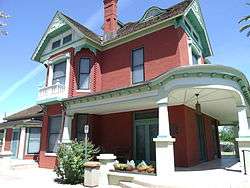 Niels Petersen House (1892) at 1414 W. Southern Ave. |
|---|
| Charles T. Hayden House was built in 1871 and is located at 2000 1 W. Rio Salado Parkway. It is the oldest building in Tempe. It was the residence of Charles Trumbull Hayden and his family. The Hayden family moved out of the house in 1889. It was listed in the National Register of Historic Places on October 10, 1984 reference #84000173. |
| The Farmer-Goodwin House was built in 1883 and is located at 820 S. Farmer Ave. in Tempe, Az.. The house is one of the best-preserved and unique adobe structures in the state. Hiram Bradford Farmer purchased the house for $3,000 in January of 1886. Farmer was the first professor and principal at the Territorial Normal School (now Arizona State University) when it opened in February of 1886. The house was later purchased by Garfield A. Goodwin and his wife. Goodwin was a businessman who once served as mayor of Tempe. List in the National Register of Historic Place on December 26, 1972 reference #72000197. |
| Roy Martin Hackett House was built in 1888 and is located at 401-405 W. 4th St. This building is the oldest fired brick building in Tempe, and perhaps possesses the most original integrity of location, design, setting, materials, workmanship, feeling and association of any territorial commercial building in Maricopa County. It was listed in the National Register of Historic Places in 1974, reference #74000458.Gov. |
| The Gov. Benjamin B. Moeur House was in built 1892 and is located at 34 E. 7th Street. The house was owned by Dr. Benjamin B. Moeur who in 1896 was the town's only full-time physician. He served two terms as governor of Arizona, while still living in this house. It was listed in the National Register of Historic Places on May 30, 2012. reference #12000295. |
| The Harrington-Birchett House was built in 1895 and is located at 202 E. 7th Street. The house was built by J.W. Harrington and sold in 1904 to Mattie Birchett. Matties' son, Joseph T. Birchett married Guess Eleanor Anderson that same year. He served as Tempe's mayor from 1912-1914. Guess was the sister of Honor Anderson Moeur, wife of Arizona Governor Benjamin B. Moeur. It was listed in the National Register of Historic Places on May 7, 1984 reference #84000716. |
| The Morrow-Hudson House was built in 1904 and is located at 1203 E. Alameda Dr. in Tempe, Az. This house belonged to Estmer W. Hudson was an Arizona pioneer who in 1916, with Charles Henry Waterhouse introduced the new Egyptian cotton, commonly known as Pima cotton. Listed in the National Register of Historic Places on May 7, 1984 reference #84000733. |
| The Hugh Laird House was built in 1908 and is located at 821 S. Farmer Ave. in Tempe, Az. The house belonged to Hugh E. Laird a businessman and public servant. Laird career was a registered pharmacist and owner of Laird and Dines Drug Store. He served 12 years as Tempe postmaster and two terms as a representative in the state legislature. He also served a 32-year consecutive seat on the Tempe City Council, 14 of those years as Mayor. Listed in the National Register of Historic Places on May 7, 1984 reference #84000726. |
| The Cummins House was built in 1909 and is located at 839 S. Farmer Ave. in Tempe, Az. Aaron and Margaret Cummins acquired undeveloped Lot 10, Block 1 of Farmer’s Addition in May 1908, mortgaged the property in March 1909, and built the house soon thereafter. Listed in the Tempe Historic Property Register. |
| The D.J. Frankenberg House was built in 1915 and is located at 2222 S. Price Road in Tempe, Az. This house was built by Don Juan Frankenberg. Frankenberg and his family were pioneers and ranchers in the Tempe area as early as 1888. In 1915, D. J. Frankenberg built this house for his family on the family homestead. That same year, he was selected to experiment with Pima Long Staple Cotton as part of the program with the Government Experimental Farm (USDA) at Sacaton, Arizona. Cotton farming was successful in the Tempe area until the loss of the market in the 1920s. Listed in the National Register of Historic Places on January 2, 2008 reference #07001333. |
| The Byron Redden House was built in 1918 and is located at 948 S. Ash Ave. in Tempe, Az. The house was built in 1918 by Charles H. Gable, and was bought by Byron Alton Redden in 1920. Byron A. Redden was a successful rancher and served 25 years as a zanjero (irrigation canal manager) for the Tempe Canal Company. Byron A. Redden lived in the house with his wife Ida M. Redden. It was listed in the National Register of Historic Places on May 7, 1984 reference #84000738. |
| The Lowell Redden House was built in 1920 and is located at 333 E. Carver St.. The property was listed in the National Register of Historic Places on February 13, 1985, reference Number 85000407. |
| The B.H. Scudder Rental House was built in 1920 and is located at 919 S. Maple Ave. The property which belonged to Benjamin Harrison Scudder was listed in the National Register of Historic Places on May 7, 1984, reference number 84000740. |
| The Scudder House was built in 1929 and is located at 959 S Ash Avenue. The house belonged to Benjamin Harrison Scudder, a local educator who built several rental houses in the Maple and Ash Avenue area. The property is listed in the Tempe Historic Property Register. |
| The Governor John Howard Pyle House was built in 1938 and is located at 1120 S. Ash Avenue. John Howard Pyle was the 9th Governor of Arizona (Arizona Governor, 1950-1954). The property is listed in the Tempe Historic Property Register. |
| The Diefenderfer House was built in 1939 and is located at 1223 S Farmer Avenue. This one-story masonry house was built with Bungalow influences by Federick and Mary Diefenderfer, a retired couple who acquired the lot in 1939. The property is listed in the Tempe Historic Property Register. |
| The Josephine Frankenberg House was built in 1910 and was originally located at 129 E. University Dr. The house was listed in the National Register of Historic Places on January 29, 1981, reference #81000138. The house was purchased by Josephine Frankenberg in 1919. Josephine nursed many victims back to health during the Great Influenza epidemic in 1918. She rented rooms on the second floor to boarders, mostly single teachers employed at the Normal School. The house remained in her possession until her death in 1949. It was dismantled and rebuilt at 150 S. Ash Ave in 1992 in Tempe's Olde Towne Square. Now lacking integrity of location, this property remains eligible for listing in the National Register of Historic Places under National Park Service Criterion B and C. The house is also listed as "Historic" in the Tempe Historic Property Survey. |
|
Associated Tempe properties
| Properties associated with notable people interred in the cemetery |
|---|
| The Hayden Flour Mill, originally built by Charles T. Hayden in 1874. |
| The historic Laird and Dines Building built in 1893. It served as Hugh E. Laird’s unofficial City Hall during his administration. |
| The Goodwin Building was built in 1907 and is located 514-518 S. Mill Ave. In 1907, Garfield Abram Goodwin completed his building with three commercial bays ─ two rentals and one for his curio store and Wells Fargo Agency. The back of half of the store was furnished as a home for the Goodwin family. The restored Goodwin building remains as the last example of cast-iron facade architecture in Tempe. Goodwin served as mayor of Tempe from 1924 to 1926. On May 06, 1984, the National Park Service (National Register of Historic Places) certified Goodwin Building as a national historic site, and assigned it the reference number 84000710. |
| Tempe National Bank Building built in 1912 (THPR). The Tempe National Bank was established on January 4, 1901, by pioneer Tempe businessmen and agriculturalists. From its establishment in 1901, the bank operated under the control and direction of the community’s most intrepid pioneers., including: Carl T. Hayden, Arizona's longtime Congressman and Senator; Cyrus Grant Jones, first president of the Tempe National Bank; and Albert E. Miller, son of Tempe pioneer Winchester Miller, a director of the Tempe Irrigating Canal Company. Thanks A. Anderson;;;, Mayor of Tempe from 1930‐1932 and 1934‐1937, began his banking career here in 1915 and went on to become branch manager and then vice‐president of the bank. Benjamin Baker Moeur, a physician and businessman in Tempe who served two terms as Governor of Arizona, had his practice in the building. |
| Marlatt’s Garage was built in 1922 and is located at 1249 E. 8th St.. The property was built by Clyde Harlen Gililland. Here he established his Gililland Motor Co. Garage business. Gililland served as Tempe’s mayor for one year (1960-1961). Eugene Marlatt owned the property from 1933 until his death in 1981. The property is listed in the Tempe Historic Property Register. |
|
See also
References
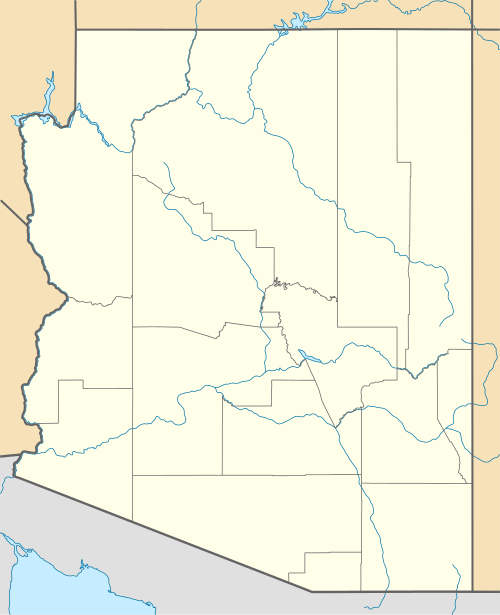



.jpg)

